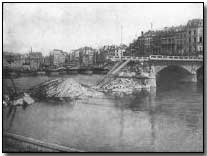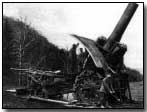Battles - The Battle of Liege, 1914
 Something of a moral victory for the Allies as represented by Belgium, the Battle of Liege ran for twelve days from 5-16 August 1914, and resulted in surprisingly heavy losses upon the German invasion force by the numerically heavily outnumbered Belgians.
Something of a moral victory for the Allies as represented by Belgium, the Battle of Liege ran for twelve days from 5-16 August 1914, and resulted in surprisingly heavy losses upon the German invasion force by the numerically heavily outnumbered Belgians.
The Battle of Liege signified the first land battle of the war, as the German Second Army crossed the frontier into neutral Belgium (since 1839) so as to attack France from the north. The Schlieffen Plan had started.
The initial aim of von Bulow's Second Army, which comprised 320,000 men, was to seize the city of Liege, gateway to Belgium, which blocked the narrow gap between the 'Limburg appendix' and the Ardennes, the best entrance into Belgium.
However Liege was defended by a ring of twelve heavily armed forts built on high ground in the 1880s, six on each side of the Meuse River, each 3-5km apart, and some 6-10km from the city itself. The forts contained a total of 400 retractable guns, up to 210mm in size. To some extent these forts offset the relatively small force at Belgian General Leman's disposal - just 70,000 men.
The Germans, under General Emmich with a force of 30,000 men, attacked at night on 5 August, sustaining heavy losses and making little or no progress, much to the surprise of the supremely confident German army.
 Ludendorff, rather than continue to attack the forts, called in the use of zeppelins to drop bombs into the city and citadel, and personally led 14th Brigade in between the forts - effectively a gap where the Belgians had intended to build rifle trenches but had not actually done so - into the city, forcing the Belgian garrison there to surrender on 7 August.
Ludendorff, rather than continue to attack the forts, called in the use of zeppelins to drop bombs into the city and citadel, and personally led 14th Brigade in between the forts - effectively a gap where the Belgians had intended to build rifle trenches but had not actually done so - into the city, forcing the Belgian garrison there to surrender on 7 August.
Nevertheless, the Germans could not hope to continue their advance through Belgium without first capturing the forts. In order to assist with this the Germans introduced a weapon which until that point remained unknown to the Allies, Austrian-built 17-inch howitzers. With the significant aid of the howitzers and the Big Bertha gun (a 420mm siege howitzer) the forts were finally taken on 16 August, General Leman having to be carried unconscious out of the besieged forts.
On the following day, 17 August, the German Second Army, together with First and Third Armies, began to implement the next stage of the Schlieffen Plan, embarking upon a wide sweeping wheel movement through Belgium, forcing the Belgian army back to Antwerp. Brussels itself was captured without resistance by General von Kluck of the First Army on 20 August.
Click here to view a map charting the progress of the German invasion of Belgium in August 1914.
Photographs courtesy of Photos of the Great War website
A "dope can" was a metal syringe containing petrol for priming an aircraft engine
- Did you know?
